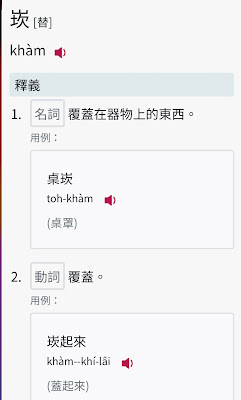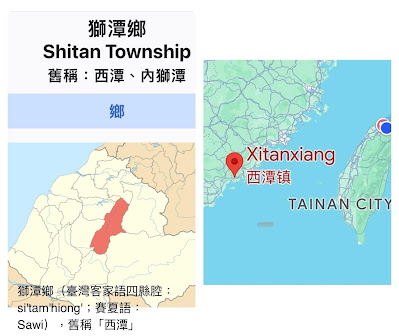Anthropology Observation II (Notes 52-82)
 |
| Kim-paoli 金包里 Qing - parián 清包里 |
Kim-paoli 金包里
Qing - parian 清包里'China town' - Fuzhou in 17th century Keelung
Atayal - Km/Kin - Qing (Qing-Manchurian-Chinese)
 |
 |
No. 53
Smangus - Sauvages (Savages)
Smangus - Sauvages (Savages)
Territoire des Sauvages (Territories of Savages)
Territoire des Sauvages (Territories of Savages)
No. 54
Taokas
Table + Techkham 桌崁/蓋
No. 55Plateau - Shangping Hsinchu Upper Plateau
Tango - reserved area
Tribus Tango - reserves indigenous area
Amis paper mulberry is Hokkien loanword 'Deer Tree' (lo-a) 鹿仔樹 .
Documented in 18th century Qing.
No. 58
Thao 'Ancestral basket' Hokkien loanword meaning 'basket'
Tsou/ Kaluvunga
Major religious symbols - Hokkien loanwords
Ihing - Green 青
Hokkien 青 tshenn · tshinn means Green
takia - ru 太祖 Ancestral spirit
Atayal MALE names - Japanese
Paiwan 'Bulay' meaning 'beautiful'- Chinese loanword 漂亮 meaning 'beautiful'
Atayal 'Balay'
Palau 'Bai'
Old English. Germanic. Proto-Indo-European
No. 64
Japanese 餅 = Mochi = RICE cake
In Japanese, "mochi" is spelled もち (motɕi) and it refers to a Japanese rice cake made from a sweet glutinous rice. The word "mochi" (餅) is also used as the umbrella term for various styles and flavors of Japanese rice cakes.
Minamoto no Yoshitsune 源 義経 - used 100 years ago with regards to Saisiyat "na" (な) and others' "no" (の) reports. (Discovery in Kyushu. Japan)
'Pangcah' Amis - People of the Pa(North)
Pa meaning North in indigenous language is Chinese/Hokkien.
No. 67
Shaman chimes - message to God
(Hezhen. Saisiyat. Mongol)
Ina - Iya 姨仔
Highland vegetables Japanese pioneered in Taipei
Pyanan - ilha - Yilan
Atayal
1.Hardworking Ina (No. 68) carrying highland cabbages at
Pyanan (南山) Yilan.
2. Pyanan etymology - likely much to do with Yilan. Unlikely what indigenous committee claim about ‘where Atayal cooked and ate’ (??). Don’t make sense to me.
3. Japanese pioneered Highland Vegetables rotation and cultivation in Zhuzi lake. 竹子湖
Qalang Smangus = Nation Savages (literal)
司馬庫斯部落
# qalang / Koka (國家) Chinese loanword meaning Nation (Tribe)
# Smangus- Sauvages French loanword meaning Savages
No. 72
#Saiya 祭屋 # Sai 祭 (Japanese)
Saisiyat Seediq Tsou 祭 - Japanese loanwords
Truku (and others) 祭 祖 - Chinese/Hokkien loanword
Tsou - ‘emo no pesia’ 祭屋
Seediq - 'Sapah Cbeyo' 祭屋
Saisiyat- 'Saiya'/'Saiyahoru' 祭屋
Truku - 'Mgay' 祭. rutux ru祖
 |
| (Source - west lafayette) |
No.73
Gaga - Koka 國家
Galang/Qalang - 聚落
land people family state country ancestral ties
Gaga
Qalang/lyung
Squliq (Saisiyat Atayal)
Niqan (Qutux Niqan - One Family)
There is a (good) possibility these are developed from
Koka 國家 - observations by the contexts and usages.
(ga qa ka ...國/家)
Ru 祖 - Check No. 59/60 (Tsou) No. 72 (Truku)
Same word root.
大豹共同體(Llyung Topa):泰雅族賽考列克群所建立的部落聯盟式國家。 大豹本社(nguq):大豹共同體下屬的部落及統治中心
No. 74
Cinsbu and Smangus - same random made-up. Atayal.
No. 76
大分 Tahun Bunun - meaning hot spring 

大分 Kyushu Japan famous for hot spring 

Peanuts - Japanese mass-cultivated peanuts in Bunun/Tsou area. Peanut oil used for tanning leather.
Which means Bunun word Tahun meaning hot spring is most likely Japanese.
There is a place in Hualien Bunun called it Tahun 大分 meaning hot spring.
I just happened to be in 大分 Kyushu Japan a couple of months ago - and photos are their produce - hot spring steamed eggs and pudding, shiitake log mushroom, highland cabbages, and peanuts.
No. 77
# Becoming important - fortunately or unfortunately.
# A culture discourages critical thinking.
A culture encouraging and thriving in ‘made-ups’ ‘hypothesis’ and ‘proposed etymologies’ (*Made-ups that can be overthrown with evidence in the 21st century*) is a culture desperately seeking importance.
When you do become important -
*Truth will come out* because people will examine your ‘made-ups’ and they will want you to validate your ‘made-up’s’ now that you are important.
That’s a natural process of becoming Important and famous.
The good news is -
you and I probably won’t live long enough to be confronted of validating these ‘made-ups’ developed over decades.
At the moment no one cares what you do. No one cares what you are making-up, what you are proposing. “So what”.
No. 78
# For 21st century
Saisiyat Shitan 獅潭 獅設族
"In ancient days - Saisiyat are 獅設族"
# A culture that discourages critical thinking # For 21st century
# A culture that encourages and thrives in fabricating 杜撰 # For 21st century
(Harmless it may appear for now because no one cares what you do and because you are not important. When you do become important as you desperately want to be -the world will want to know why you persistently fabricate # For 21st century and why that's considered normal in your culture # For 21st century)
Saisiyat Shitan 獅潭 獅設族 In ancient days - Saisiyat are 獅設族.
Shitan 獅潭 Miaoli Taiwan formerly Xitan 西潭 - predominantly Hakka township in Zhangzhou Fujian China.
The Hakka connection is so strong that you can't even hide it # For 21st century.
No. 79
Sawi 西潭 - Saisiyat (southern)
Si'tam 西潭 - hiong 鄉 - Hakka Taiwan
Xitan 西潭 - xiang 鄉 - Fujian China
SaWI - Si'TAM = 潭
Si'tam HIONG - XitanXIANG - 鄉
That appears logical.
Which means Saisiyat name Sawi 西潭 could not have existed before 19th century. And
'Saisiyat' this name could not have existed before 19th century - it could not have been 'ancient' 古時 being less than 300 years old.
No. 80
1. It doesn’t appear any indigenous studies academic/scholar knows this -
蓬萊 = Horai (Japanese)
Or if they know they didn’t get it.
3. 坪 plateau upper and lower developed into phonological variations in Atayal and Saisiyat. But they all mean exactly 坪。(Chinese)
No. 81
Classic etymology made-ups
Boulder
Fertile land
Steamy hot water
# A culture indulges in and encourages etymology made-ups. They go like this -
Boulder No. 3 No. 77
Shibi/RaiSnay 石壁 Re’nai 瑞岩 (Atayal)
In ancient times - our ancestors arrived in this place with Big Rock 岩 Wall 壁 (nay.nai) and there the beginning of our people and history.
(Fact - 石壁 and 瑞岩 are both Fujian place names with significant Hakka presence.)
Fertile land No. 70, 74
Cinsbu and Smangus - same random made-up. Atayal.
In ancient times - our ancestors arrived in this land full of richness and resources and the sun rises. Here our land cultivated, our people thrived.
(Fact - Smangus is French loanword Sauvages= Savages. Cinsbu etymology play-on-Chinese words - random makeup)
Steamy hot water No. 5, 76
大分 Tahun Bunun - meaning hot spring
湯社 U'lay (Wulai)
In ancient times - our ancestors arrived in this place and saw hot steamy water and they shouted out
"U'lay" "Tahun".
(Facts - U 湯 is Japanese. Tahun 大分 has significant Japan influence)
No. 82
Galang/Gaga - Chinese loanword- 國家/家
raho - Chinese loanword - 領袖
Galang/Qalang - 聚落
(No wonder keep reading you find them in such proximity either in context or phonetics.)
These are developed from Han Chinese vocabulary.
that’s how they work.
部落(galang/alang)(Qalang) 聚落
傳統領袖(maraho)
祭祀團體(gutux gaga)
狩獵團體(inhoyan qutux linntan/inltan)
............
and so on.
(No. 83 東河 Amis Saisiyat - sugar 都蘭 Walo)
RELATED POSTS
1. Becoming Indigenous (I) HERE
2. Japanese or Tagalog? Formosan Language Analysis - An Eastern Taiwan Example HERE
5. Full-Blooded Han Chinese Becoming Indigenous Leaders (17-20th century) HERE


















































.jpg)


.jpg)





























Comments
Post a Comment